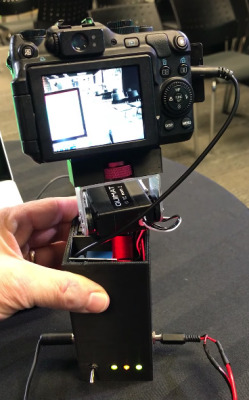Take a second to imagine all the people in your life. Your family, friends, coworkers. Your buddies down at the hackerspace, and anyone you chat with on IO and over the airwaves. Statistically speaking, one in four of these people has a disability of some kind, and needs help doing everyday things that you might not think twice about — simple things like opening doors or interacting with computers. Or maybe that one in four is you.
For the past 75 years, United Cerebral Palsy of LA (UCPLA) have been helping people with various developmental and intellectual disabilities to live independently with dignity. They work directly with members of the disabled community to develop assistive technology that is both affordable and dependable. UCPLA helps the disabled community with everything from employment to providing a creative outlet, and gives them the tools to do these things and more. Their mission is to help people be as independent as possible so they can feel good about themselves and enjoy a life without limits.
 The people behind this non-profit are all about inclusion, access, and opportunity, and this is why we are proud to partner with UCPLA for the 2020 Hackaday Prize. With the world in upheaval, there is no better time to build a better future for everyone. You never know when you might need assistive technology. In addition to the open challenge that calls for everyone to work on a design, this year there is also a Dream Team challenge which offers a $3,000 per month stipend over the next two months to work on a team addressing one specific challenge. Apply for that asap!
The people behind this non-profit are all about inclusion, access, and opportunity, and this is why we are proud to partner with UCPLA for the 2020 Hackaday Prize. With the world in upheaval, there is no better time to build a better future for everyone. You never know when you might need assistive technology. In addition to the open challenge that calls for everyone to work on a design, this year there is also a Dream Team challenge which offers a $3,000 per month stipend over the next two months to work on a team addressing one specific challenge. Apply for that asap!
What kind of challenges has UCPLA outlined for the Hackaday Prize? Let’s dive in and find out, and we’ll also hear from the UCPLA team in a Q&A video at the end of the article.
Continue reading “Hackaday Prize And UCPLA Are Driving Assistive Technology Forward”




 Most people don’t know they can contract their middle ear muscle, technically called the tensor tympani, but will recognise it as a rumbling sound or muffling effect of your hearing when yawning or tightly closing eyes. Its function is actually to protect your hearing from loud sounds screaming or chewing. [Nick] ran a survey and found that 75% can consciously contract the tensor tympani and 17% of can do it in isolation from other movements. Using a cheap USB auroscope (an ear camera like the one [Jenny] reviewed in November), he was able to detect the movement using iSpy, an open source software package meant for video surveillance. The output from iSpy is used to control Grid3, a commercial assistive technology software package. [Nick] also envisions the technology being used as a control interface for consumer electronics via earphones.
Most people don’t know they can contract their middle ear muscle, technically called the tensor tympani, but will recognise it as a rumbling sound or muffling effect of your hearing when yawning or tightly closing eyes. Its function is actually to protect your hearing from loud sounds screaming or chewing. [Nick] ran a survey and found that 75% can consciously contract the tensor tympani and 17% of can do it in isolation from other movements. Using a cheap USB auroscope (an ear camera like the one [Jenny] reviewed in November), he was able to detect the movement using iSpy, an open source software package meant for video surveillance. The output from iSpy is used to control Grid3, a commercial assistive technology software package. [Nick] also envisions the technology being used as a control interface for consumer electronics via earphones. [Taras Slawnych] heard about [Carolyn’s] need for special camera equipment and figured he had the experience to do something about it. With an Arduino and a couple of servos to drive the pan-tilt mechanism, he came up with
[Taras Slawnych] heard about [Carolyn’s] need for special camera equipment and figured he had the experience to do something about it. With an Arduino and a couple of servos to drive the pan-tilt mechanism, he came up with 





Gloss